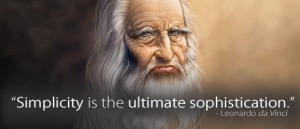Tags
Behavior, Business Education, Communications, Da Vinci, Design, Design Thinking, Effective Decision Making, Form, Function, Impact, John Gero, Minimalism, Presentations, Public Speaking, Reliability, Roger Martin, Simplicity, Structure, TED, Validity

I ran across this talk by Roger Martin which is, in my opinion, the quintessential example for a superlative presentation. One of my key criteria for “superlative” is that the audience is inspired and more importantly, there is a good chance the message will be remembered, i.e. that the speaker will generate an impact.
Here are the elements that make this great in my view: a single visual, a comfortable speaking pace with pauses, a few terms which are well defined as they are introduced, and lots of examples.
Unfortunately this type of presentation is the opposite of what we’re used to in the business world. The presentation norm from the likes of top consulting firms, business schools and even TED events is mind numbing data and graphics and a speaking pace rivaling that of auctions as undeniable proof of intelligence.
In his talk, Roger Martin contrasts analytical and design thinking. With a wonderful resonance between form and function, Roger Martin not only talks the design talk but walks the design walk. The format of the presentation presents a minimalist design that reinforces in form the semantics of the message. By contrast, the 50+ slide presentations with dizzying graphics that none of us seem to be able to escape could also be said to follow in form the predominantly analytical thinking of the business community with an obsession for numbers and statistical proof.
In closing, I believe our leaders should have simplicity of form for communications as a goal. This would help avert information overload and facilitate richer dialogue and more effective decisions. Design format is not just a nice to have, it can have very concrete repercussions. As Leonardo Da Vinci has said, “simplicity is the ultimate sophistication” and we shouldn’t be afraid that a minimalist form takes away from the credibility of the message. The caveat is that simplicity can only be attained with a fundamental insight, and, in lack of a fundamental insight, many of our experts are forced to go for the volumes of data approach.
Do take 10 minutes to watch this video if you have a quiet moment, the message is as powerful as the format.
Additional pointers to the relationship between form and function:
Dr. John Gero presents a wonderful model for the relationship between function, structure and behavior in design processes.
Dr. Elliott Jaques, inventor of the “midlife crisis” concept and the Requisite Organization Theory, developed a speech analysis method to probe mental potential.
